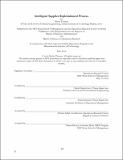| dc.contributor.advisor | David Simchi-Levi and Jonas Jonasson. | en_US |
| dc.contributor.author | Thomas, Merin,M.B.A.Sloan School of Management. | en_US |
| dc.contributor.other | Sloan School of Management. | en_US |
| dc.contributor.other | Massachusetts Institute of Technology. Operations Research Center. | en_US |
| dc.contributor.other | Leaders for Global Operations Program. | en_US |
| dc.date.accessioned | 2019-11-12T18:12:46Z | |
| dc.date.available | 2019-11-12T18:12:46Z | |
| dc.date.copyright | 2019 | en_US |
| dc.date.issued | 2019 | en_US |
| dc.date.issued | 2019 | en_US |
| dc.identifier.uri | https://hdl.handle.net/1721.1/122904 | |
| dc.description | This electronic version was submitted by the student author. The certified thesis is available in the Institute Archives and Special Collections. | en_US |
| dc.description | Thesis: M.B.A., Massachusetts Institute of Technology, Sloan School of Management, in conjunction with the Leaders for Global Operations Program at MIT, 2019 | en_US |
| dc.description | Thesis: S.M., Massachusetts Institute of Technology, Operations Research Center, in conjunction with the Leaders for Global Operations Program at MIT, 2019 | en_US |
| dc.description | Cataloged from PDF version of thesis. | en_US |
| dc.description | Includes bibliographical references. | en_US |
| dc.description.abstract | Company X is facing high cost to serve customers such as hospitals and clinics, due to irregular ordering pattern. Currently, the customer ordering process is not well planned and leads to multiple orders in a month, thereby excessive shipping and increased cost to serve. The supplies provided to customers are used for specimen collection, and the collected specimen are sent to diagnostic laboratories for analysis. Historical data on order quantities of specimen collection items (SCIs) and specimen containers returned to lab are available. This project takes advantage of the closed loop nature of the system to predict order quantities of SCIs. This project explores two replenishment strategies and compares it with the current method, through simulation. | en_US |
| dc.description.abstract | The simulation models the daily consumption of SCIs at a chosen Patient Service Center (PSC), and estimates average inventory levels and the number of occurrences of stockouts for each SCI at the PSC, for varying values of parameters such as review period and safety stock levels. The two replenishment strategies are (a) constant order quantity, in which fixed replenishment quantities of SCIs are supplied every review period, and (b) predictive modelling replenishment strategy, in which the order quantities of SCIs are predicted using the data on specimen containers returned to diagnostic lab for analysis. For the latter strategy, multiple models for prediction, such as penalized regression, Classification and Regression Trees (CART) and Random Forest are used. Two parameters, the total replenishment costs and the number of occurrences of stockouts, are measured to evaluate the performance of the replenishment strategies. | en_US |
| dc.description.abstract | The total cost of replenishment for constant quantity strategy is comparable to that of baseline case, whereas predictive modelling strategies have much higher cost. The constant quantity strategy with increased levels of safety stock gives best results of reducing the total cost of replenishment and minimizing the number of occurrences of stockouts. | en_US |
| dc.description.statementofresponsibility | by Merin Thomas. | en_US |
| dc.format.extent | 52 pages | en_US |
| dc.language.iso | eng | en_US |
| dc.publisher | Massachusetts Institute of Technology | en_US |
| dc.rights | MIT theses are protected by copyright. They may be viewed, downloaded, or printed from this source but further reproduction or distribution in any format is prohibited without written permission. | en_US |
| dc.rights.uri | http://dspace.mit.edu/handle/1721.1/7582 | en_US |
| dc.subject | Sloan School of Management. | en_US |
| dc.subject | Operations Research Center. | en_US |
| dc.subject | Leaders for Global Operations Program. | en_US |
| dc.title | Intelligent supplies replenishment process | en_US |
| dc.type | Thesis | en_US |
| dc.description.degree | M.B.A. | en_US |
| dc.description.degree | S.M. | en_US |
| dc.contributor.department | Sloan School of Management | en_US |
| dc.contributor.department | Massachusetts Institute of Technology. Operations Research Center | en_US |
| dc.contributor.department | Leaders for Global Operations Program at MIT | en_US |
| dc.identifier.oclc | 1126283912 | en_US |
| dc.description.collection | M.B.A. Massachusetts Institute of Technology, Sloan School of Management | en_US |
| dc.description.collection | S.M. Massachusetts Institute of Technology, Operations Research Center | en_US |
| dspace.imported | 2019-11-12T18:12:45Z | en_US |
| mit.thesis.degree | Master | en_US |
| mit.thesis.department | Sloan | en_US |
| mit.thesis.department | OperRes | en_US |
